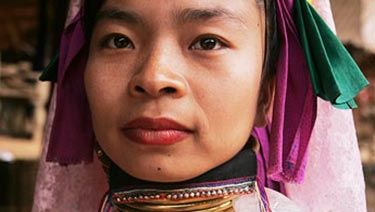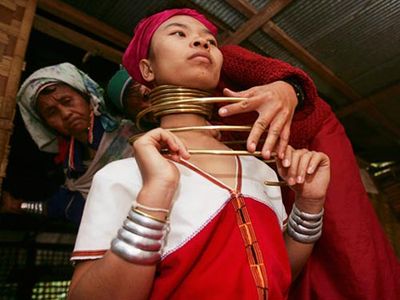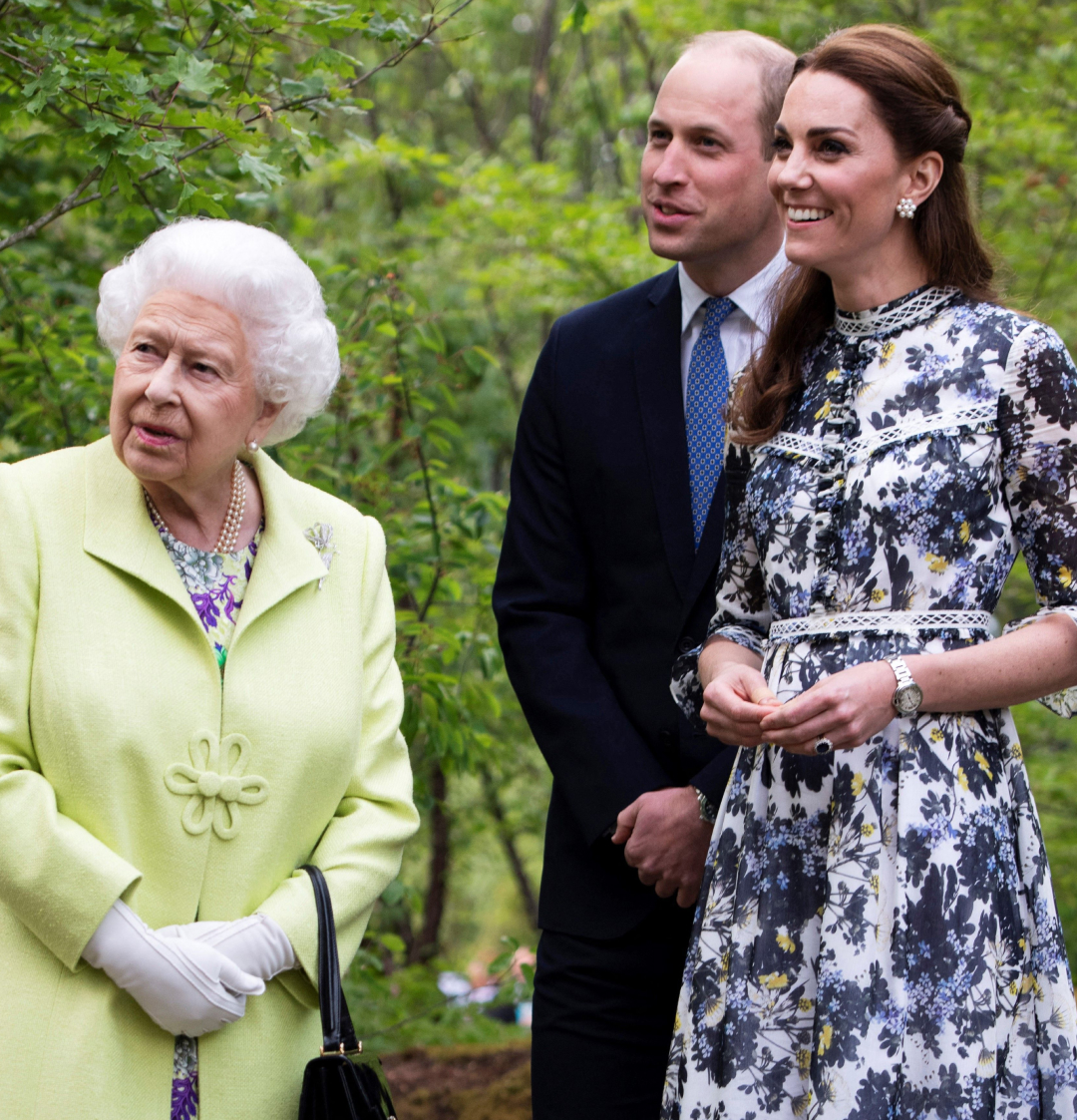Please Set Me Free
Forced to serve as a tourist attraction in a human zoo, the long-neck women of Thailand want to cast off their coils and live modern lives like the rest of us — if only the government would let them.

Zember, a quick-witted young woman with a cheerful, oval face, doesn't want to be a human exhibit. Ever since she was 5, she has worn brass rings around her neck and smiled at foreigners who tromp through her rural village in Thailand. For tourists, it seems like the adventure of a lifetime — riding in a jeep through the snake-infested jungle to see the exotic "long-neck women" of the Kayan tribe. But now Zember has removed her coil — in protest of her captivity. She no longer wants to keep Thailand's shameful secret: that the long-neck women are Burmese refugees who are being prevented by Thai authorities from taking up asylum overseas. As a lucrative tourist attraction, the women are forced to live in a virtual human zoo.
Sitting in a small cafe in the town of Mae Hong Son, not far from her village, Zember, 23, strokes her bare throat and says it feels strange that no one is staring at her. She and a number of other Kayan refugees have been offered resettlement in countries such as New Zealand and Finland, but Thai authorities won't hand over the exit visas. "They don't want us to leave because it will hurt tourism," says Zember. "But I don't want to be put on display anymore."
The 500 or so Kayans (also known as Padaung) who live in Thailand fled the brutal military regime in neighboring Burma (also known as Myanmar) two decades ago, and they have been confined in three guarded villages on the northern Thai border ever since. An estimated 40,000 tourists per year, many of them Americans, pay about $8 each to gawk at the women's giraffe-like appearance. In return, the long-neck women earn a paltry salary of 1500 baht ($45) a month selling souvenirs and postcards. Few tourists are aware of the scandalous situation, Zember explains, because the women's wages are docked if they discuss their plight. So they "smile and say nothing."
Zember and her family were accepted for resettlement by New Zealand in 2006 as part of a wide-scale program organized by the U.N.'s refugee agency, UNHCR. Five other long-neck families are also due to relocate to New Zealand and Finland but lack the exit permits. "We have all the other paperwork," says Zember, waving a crumpled plastic folder of documents. Hundreds more Kayans have also applied for resettlement, but approval of their cases is stalled indefinitely until the exit-permit issue is resolved.
"As official refugees, the Kayans have a right either to resettlement abroad or to full Thai citizenship. They are being given neither," says Kitty McKinsey, the UNHCR's regional spokeswoman in Bangkok. She points out that over the past two years, Thailand has issued exit permits for more than 20,000 other Burmese refugees who lack the Kayans' commercial value. "The Kayans should be treated the same as other refugees," McKinsey says.
The UNHCR, as well as the New Zealand and Finnish governments, say they are lobbying the Thai authorities to this end. But the local government in Mae Hong Son — Thailand's poorest province, which depends heavily on tourism — remains impassive. Governor Thongchai Warianthong, the official responsible for signing the exit permits, at first agreed to talk to Marie Claire, but when he learned what the interview was about, he suddenly became "unavailable." The following week, he issued a statement to the Thai press saying the Kayans are "happy and comfortable with their lives" in Thailand. The Royal Thai Embassy in Washington, DC, hadn't returned calls on the matter as of press time.
Zember is living proof that the Kayans aren't content. "Some people of my mother's generation say they are too old [to leave] now, but no one is happy," she says, shaking her head. "We have no freedom and life is very hard." The three long-neck villages in the area lack basic sanitation and medical care and are plagued by tropical diseases. Zember is still traumatized by the death of a close friend two years ago — a 22-year-old beauty named Ma Da. "She complained of stomach pains, but we had no doctor and she died," says Zember, pointing out a postcard with Ma Da's smiling face hovering above her coiled neck. "That could happen to any of us."
Stay In The Know
Get exclusive access to fashion and beauty trends, hot-off-the-press celebrity news, and more.
Wearing her long, dark hair loose, and a lace-edged khaki tee with black cargo pants and no neck rings, Zember looks like any other modern Asian woman. (Contrary to popular belief, the women's necks are not abnormally long and do not snap when the rings are removed. The coil, which weighs up to 25 pounds, creates the illusion of a long neck by depressing the collar bones.) Zember's cell phone — a lifeline to the outside world — is permanently clamped to her ear. She checks the Internet often and can hold forth on anything, from Iraq to the troubles of her idol, Britney Spears. "People see us as aliens from another planet. They're shocked [to realize] we're normal human beings," she says in tentative English.

Zember's coil required almost two hours to be removed by her skilled elder sister (it takes even longer to put on). The women wear the coils, which are made by Burmese craftsmen, from childhood, starting with four or five rings and adding more each year as they grow accustomed to the bruising and discomfort caused by the weight on their collar bones. They sleep in them and pad their necks with leaves to prevent chafing and sores. Not even the Kayans know for sure how the tradition originated. One theory claims the rings were designed to deter attacks from tigers (which grab victims by the neck), while another says they were meant to lessen the women's beauty, to ward off men from rival tribes.
One of Zember's friends, Ma Lo, 24, who has also removed her neck rings, says the women are punished for doing anything modern, like using cell phones or computers. "The owners of the villages dock our wages," she says. "They say it ruins our traditional image and tourists won't pay." In fact, the two women receive no salary at all now, and their refugee status prevents them from finding other work.
Zember, who hopes to become a nurse, admits she has only a fuzzy idea of what life abroad might be like if she escapes. "I learned on the Internet that there are more sheep than people in New Zealand," she laughs. But she knows a bit about the West from the backpackers she sees. "The girls look so free and sexy, and their eyes shine," she says. "I stare at them and feel even more determined to fight to get out of here."
Click here to see more photos of the long-neck women — with and without their coils.
Tell us what you think - we'll send your letters to the Thai embassy and the UNHCR.
Or, donate to LinkHandsForHumanity.com
-
 What Is the "Protect the Dolls" Tee
What Is the "Protect the Dolls" TeeCelebrities from Pedro Pascal to Tilda Swinton have co-signed Conner Ives’s slogan tee, turning it into a viral rally cry that has already raised over $300,000 for Trans Lifeline.
By Sara Holzman
-
 The 'Weak Hero Class 2' Cast Breaks Down Its Shocking Ending, From the Major Team-Up to the Tragic Death
The 'Weak Hero Class 2' Cast Breaks Down Its Shocking Ending, From the Major Team-Up to the Tragic DeathStars Park Ji-hoon, Ryeo-un, Choi Min-yeong, and Lee Min-jae have a lot of thoughts about the K-drama's epic finale.
By Quinci LeGardye
-
 Prince William and Princess Kate's "First Priority" Is "Very Different" Than Queen Elizabeth's Was
Prince William and Princess Kate's "First Priority" Is "Very Different" Than Queen Elizabeth's WasThe Prince and Princess of Wales are changing the modern monarchy.
By Kristin Contino
-
 36 Ways Women Still Aren't Equal to Men
36 Ways Women Still Aren't Equal to MenFeatures It's just one of the many ways women still aren't equal to men.
By Brooke Knappenberger
-
 EMILY's List President Laphonza Butler Has Big Plans for the Organization
EMILY's List President Laphonza Butler Has Big Plans for the OrganizationUnder Butler's leadership, the largest resource for women in politics aims to expand Black political power and become more accessible for candidates across the nation.
By Rachel Epstein
-
 Want to Fight for Abortion Rights in Texas? Raise Your Voice to State Legislators
Want to Fight for Abortion Rights in Texas? Raise Your Voice to State LegislatorsEmily Cain, executive director of EMILY's List and and former Minority Leader in Maine, says that to stop the assault on reproductive rights, we need to start demanding more from our state legislatures.
By Emily Cain
-
 Your Abortion Questions, Answered
Your Abortion Questions, AnsweredHere, MC debunks common abortion myths you may be increasingly hearing since Texas' near-total abortion ban went into effect.
By Rachel Epstein
-
 The Future of Afghan Women and Girls Depends on What We Do Next
The Future of Afghan Women and Girls Depends on What We Do NextBetween the U.S. occupation and the Taliban, supporting resettlement for Afghan women and vulnerable individuals is long overdue.
By Rona Akbari
-
 How to Help Afghanistan Refugees and Those Who Need Aid
How to Help Afghanistan Refugees and Those Who Need AidHow To With the situation rapidly evolving, organizations are desperate for help.
By Katherine J. Igoe
-
 It’s Time to Give Domestic Workers the Protections They Deserve
It’s Time to Give Domestic Workers the Protections They DeserveThe National Domestic Workers Bill of Rights, reintroduced today, would establish a new set of standards for the people who work in our homes and take a vital step towards racial and gender equity.
By Ai-jen Poo
-
 The Biden Administration Announced It Will Remove the Hyde Amendment
The Biden Administration Announced It Will Remove the Hyde AmendmentThe pledge was just one of many gender equity commitments made by the administration, including the creation of the first U.S. National Action Plan on Gender-Based Violence.
By Megan DiTrolio